Breast cancer research opportunities give students unique learning experience, opportunity to help others
Lipscomb's College of Liberal Arts & Sciences is giving students hands-on learning opportunity to engage in research to help others.
Kim Chaudoin |
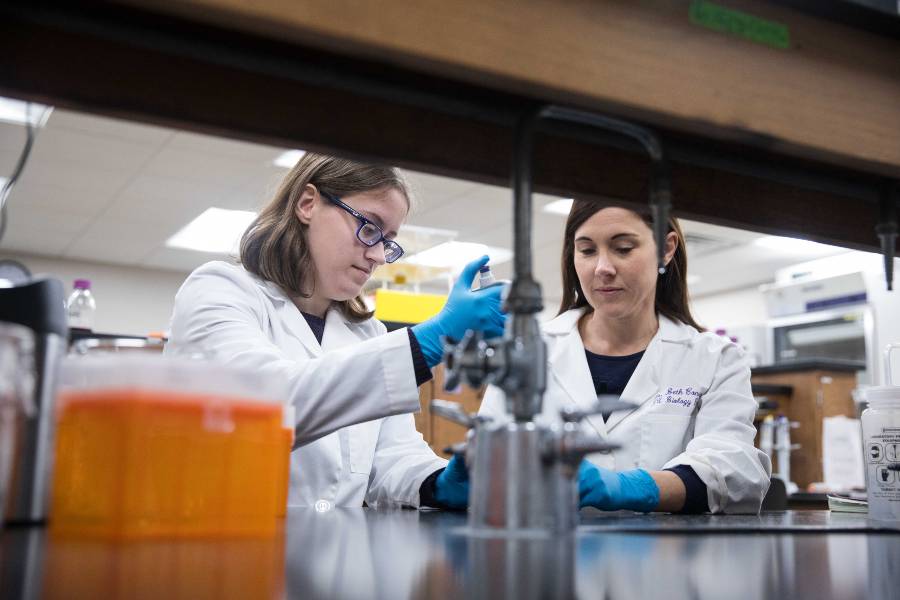
While the nation’s attention turns to the fight against breast cancer every October, Dr. Beth Conway and her team of student researchers are continually hard at work seeking to discover clues at the cellular level for understanding and treating this prevalent form of cancer.
According to the National Breast Cancer Research Center, in 2020, an estimated 276,480 new cases of invasive breast cancer will be diagnosed in women in the U.S. as well as 48,530 new cases of non-invasive (in situ) breast cancer. This year, an estimated 42,170 women will die from breast cancer in the U.S. and 1 in 8 women will be diagnosed with breast cancer in her lifetime
Conway has devoted years to breast cancer research and is passionate about giving students the opportunity to gain experience in the lab as part of the process.
“I began my breast cancer research wanting to better understand what makes some breast cancers more invasive and metastatic than others,” said Conway, associate professor of biology and chair of the department, which is housed in the College of Liberal Arts & Sciences. “This led me to a group of proteins called the endothelin axis. My lab is still studying these proteins in breast cancer invasion.”
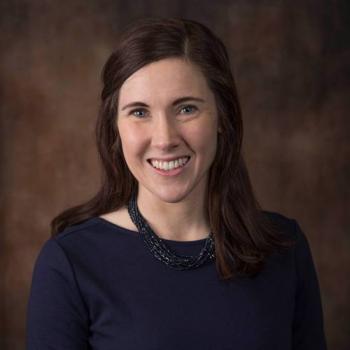
Dr. Beth Conway
Examining Endothelin B receptor protein
For the past five years, Conway and student researchers have examined the four main types of the Endothelin B receptor protein. The endothelins and their receptors are best known for their regulation of the vascular system. Their widespread expression in epithelial cells and their overexpression in some tumors has prompted investigation into their ability to regulate cancer progression, Conway explained. In this study, Conway and her student researchers assessed the mRNA expression of the major endothelin B receptor gene (EDNRB) isoforms and found differences in both mRNA and protein expression in normal breast cells and breast cancer cell lines.
“So there are four major forms of that same protein and nobody had looked closely enough at it to know which forms were most important in breast cancer,” she explained. “Sometimes different forms of protein will actually have different functions. So we wanted to know if these four main forms of Endothelin B receptor varied in their expression or function in breast cancer.”
Students have been a part of the research efforts since the beginning of this study. Conway said students were integral in shaping the focus of the research.
“At the beginning of the project five years or so ago a student suggested that we really needed to be looking at this protein, and I hadn't been looking at it before but had been looking at something else in that family. So he really pushed me to look at this,” she admitted. “I just love that as an example not just of how we can learn more about breast cancer, but about how students and researchers can push each other to see things that I wouldn't have seen on my own.”
Student research published in Journal of Cancer
Conway said the research revealed some differences, especially when examining low grade cancers versus high grade cancers. We were interested in understanding, do those do the same thing, or do they do different things in breast cancer cells.
What they found is that knocking down the EDNRB gene in breast cancer cells altered invasiveness toward endothelin 3 (ET3). They observed EDNRB isoform-specific regulation of breast cancer cell invasion and cell signaling, as well as isoform- and subtype-specific differences in breast cancer patient survival. In February, Conway and 16 students who worked on the project at some point, had their study, “Differences in Endothelin B Receptor Isoforms Expression and Function in Breast Cancer Cells,” published in the Journal of Cancer. The results reported in their study emphasize the importance of the endothelin B receptor in breast cancer. Conway said to her knowledge, this study is the first to clarify the differential expression and roles of specific EDNRB isoforms in breast cancer.
At the beginning of the project five years or so ago a student suggested that we really needed to be looking at this protein, and I hadn't been looking at it before but had been looking at something else in that family. So he really pushed me to look at this. I just love that as an example not just of how we can learn more about breast cancer, but about how students and researchers can push each other to see things that I wouldn't have seen on my own. — Dr. Beth Conway
“So that helps us understand the biology of that protein and breast cancer better. We could think about using it as a potential biomarker to look at specific forms of proteins and cancer patients to predict if they are likely to have breast cancer that would be more aggressive or more invasive over time. And perhaps it could mean that we could try to target one form of that protein specifically — target the harmful form of it without targeting the one that is preventing invasion,” explained Conway.
Having 16 student researchers as part of the published study was satisfying, Conway said.
“We have been working on this for a number of years and it is satisfying to have it published. It was really exciting for so many students to get their research published for the first time. Because we only get students for maybe six months or a year to participate in the research, there are a lot of small pieces that come together,” she said. “It’s so rewarding for our students to be able to have this kind of experience and to be published.”
Continued research of triple negative breast cancer
In addition to the recently published study, another research initiative has been in progress in Conway’s lab that looks at a more specific type of breast cancer — triple negative breast cancer. Triple-negative breast cancer is a kind of breast cancer that does not have any of the receptors that are commonly found in breast cancer, such as estrogen, progesterone and human epidermal growth factor. So doctors have fewer solutions for treatment.
This form of breast cancer is the most difficult type of breast cancer to treat, as it is often very aggressive but does not respond to traditional chemotherapy or other targeted therapies, Conway said. Finding biomarkers that can lead to targeted therapy for this cancer is an important area of research. Data studied suggests that neprilysin is associated with changes in the P13K Pathway. Conway published a paper in 2015 in collaboration with a number of students looking at the role of neprilysin, the main protein that shuts down endothelin signaling, and its role in breast cancer invasion. Conway’s current research studies the mechanism linking neprilysin with the PI3K pathway to determine whether neprilysin methylation could be a biomarker for targeted therapy.
“We've been studying it for a while, but we wanted to understand that a little bit more broadly,” Conway explained. “Neprilysin is a protease, which means it breaks down other proteins. By cutting, it can cut out a number of other proteins. We know that those proteins that it's cutting have important functions that can be relevant to cancer. Neprilysin is on the surface of the cell. So the cutting of the proteins is happening just outside the cell surface.”
The remaining pieces of proteins can bind to other proteins on the cell surface and then send signals inside the cell to change their behavior.
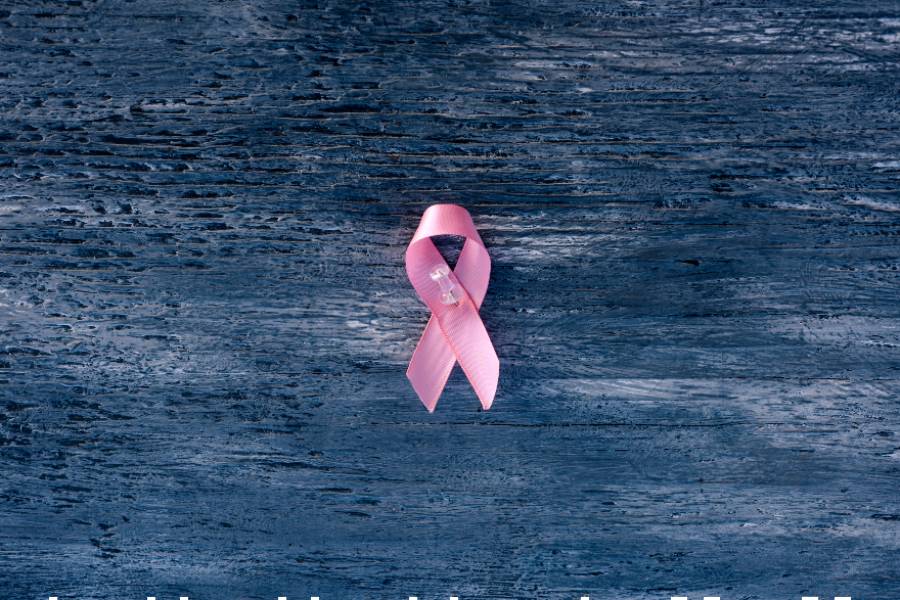
“Because it can cut a lot of proteins, we thought it could be signaling to a lot of other proteins inside the cell, that would be important in changing the behavior of a cancer cell,” continued Conway. “So essentially, we wanted to know what other major pathways inside of the cell are like proteins that function together to do the same thing. What are other protein pathways and cancer cells — specifically in breast cancer what are the cells that neprilysin is regulating? That's our big question.”
The PI3K pathway is the most mutated pathway, she said, meaning that various proteins are mutated but that there are a few key proteins “just keep seeing popping up in most cancers.”
Clinical trials have tried to shut that pathway off in triple negative patients, and some patients seem to respond while others do not. According to Conway, no one really knows why. It's not obvious why some respond to drugs that target that pathway, and others do not, suggesting that there may be other proteins that are regulating that particular pathway.
Students provide key research assistance
Students have gathered bioinformatics data from tumor samples that suggests neprilysin might be regulating the PI3K pathway.
Conway described the process as being like a dimmer on a light switch. The PI3K pathway determines if this is going to be a cancer cell or not. Then neprilysin could amplify the signal and could turn up the PI3K pathway and make it work harder.
“We have some data suggesting that neprilysin might be one of the proteins that is regulating that pathway. That's important, because if neprilysin is regulating that pathway,we want to know if neprilysin can predict how well cancers respond. So if these triple negative breast cancers have a lot of neprilysin, and PI3K mutation, are they more or less likely to respond to a drug that blocks that pathway than cancer cells that don't have a lot of resilience,” Conway said.
“We're looking at a lot of different proteins,” she continued, “and we have to introduce a lot of controls to see if that's actually happening. Then we'll start testing the second part of that, which is addressing whether we can treat the cancer cells with drugs, then determining whether the presence of neprilysin makes a difference. We're in the middle of that right now.”
Students are an integral part of Conway’s research team. Their tasks vary depending on the stage of the research process. Most of the research is done outside of class time or as part of an independent research course and often during the summer.
Students are currently growing cancer cells that are transfected. Transfection is the process of artificially introducing nucleic acids (DNA or RNA) into cells, utilizing means other than viral infection. This allows them to take cancer cells, and introduce neprilysin into them. They are also examining cancer cells that have a lot of that protein and trying to knock it down using CRISPR technology, a simple yet powerful tool for editing genomes. It allows researchers to easily alter DNA sequences and modify gene function. Its many potential applications include correcting genetic defects, treating and preventing the spread of diseases and improving crops.
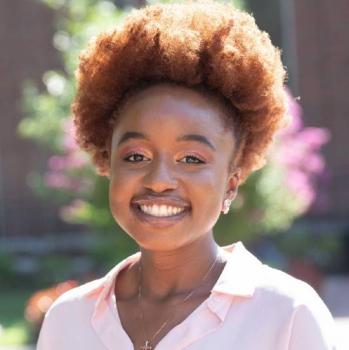
Kiandra Hawkins
“CRISPR is kind of a big deal in bio technology right now. So we're trying to use CRISPR as a way of kind of looking at the opposite side of transfection … to take cancer cells that usually express neprilysin and get rid of it,” said Conway.
Students are adding genes into the cells and are examining the RNA and the protein from those cells. They will measure gene expression and do a western blot, which looks at protein expression. Students each study different antibodies, which are proteins specific to the protein that they're looking for to measure the impact of neprilysin in these cancer cells.
Kiandra Hawkins, a senior biology major from Columbia, Tennessee, is currently assisting with Conway’s research. She has been working on completing a western blot. Her work involved washing and imaging the blots in order to elucidate specific proteins of interest.
“The experience was very eye opening for me. No one I personally know has ever gotten to do research before, so going into it I had no clue what to expect,” said Hawkins. “The work I have done in the lab has been quite tedious at times and gave me a newfound appreciation for the scientists who do that type of work all day. It also helped connect much of the abstract concepts that I've learned in class to tangible ideas that I am now better able to visualize since I have been exposed to it in person.”
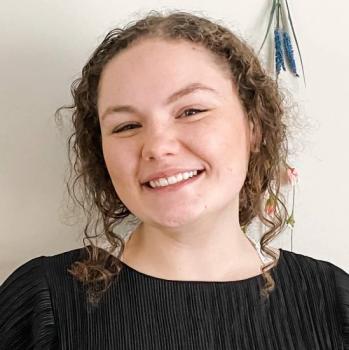
Erin Whiting
Though Hawkins said she doesn’t plan on having a career in research in the future, the chance to participate in research this semester is an opportunity that she said will help guide her future plans.
“It also helped increase my confidence because I always felt like research was something that I wasn't ‘smart enough’ for,” she admitted. “Overall, the experience is one that not only helped me grow my confidence but also give insight into the behind the scenes work that goes into improving the world of medicine.”
Erin Whiting, a senior molecular biology major from Huntsville, Alabama, is also currently working in Conway’s lab. She has been working on determining the effects of neprilysin expression in triple negative breast cancer cell lines through different lab protocols such as western blots. She said the experience has been rewarding.
“The experience has been great,” said Whiting, a 2020-21 Langford Yates Scholar. “It has challenged me as a student and I have honed critical thinking skills, practiced lots of patience, and I feel more well-rounded as a person. Dr. Conway is an amazing PI and is always gracious and helpful when it comes to troubleshooting, determining next steps in the lab, and walking me through procedures. I have really valued this experience and would venture to say it is one of the most impactful experiences I have had in my time at Lipscomb. I'm excited to continue making headway on this project and keep working with Dr. Conway.”
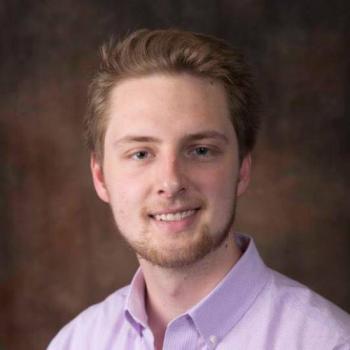
Kase Maner
Senior molecular biology major Kase Maner’s role in the research project is to conduct independent reading to stay up-to-date on the newest research pertaining to his team’s investigation and to run several experiments in the lab to determine protein concentrations.
“The number of incredibly unique opportunities like this at Lipscomb is remarkable. Research has taught me a great deal about responsibility, collaboration, and patience,” said Maner, from Columbia, Tennessee. “Dr. Conway is extremely helpful when it comes to advising and helping students navigate any issues they may encounter in the lab.”
Edom Seyoum is in her first semester as a member of Conway’s research team. A senior biology major from Addis Ababa, Ethiopia, Seyoum said the experience has been educational.
“I realized that I have to be patient in doing research because some experiments take a long time,” admits Seyoum. “I love doing research with Dr. Conway. I've learned so much in the lab from making buffers to running western blots. As I continue doing research with Dr. Conway, I hope to learn much more. I've worked with Dr. Conway for a short amount of time but I've learned a lot so much already and I can't wait to learn much more. I love my time in her lab.”
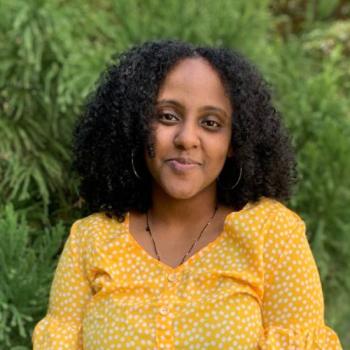
Edom Seyoum
Having students involved not only provides valuable resources for Conway, but gives students unique hands-on learning opportunities. In addition, they have experience for their resumes that prepares them for additional research and entering Ph.D. programs. She said it has been rewarding through the years to talk to former students about their research projects, job interviews and graduate experience.
“I received a phone call from a research student of mine just a few days ago, and he had gotten accepted into medical school and during the interview all they wanted to talk about was his research in my lab. Of course his test scores were important in getting accepted, but he felt like the research he did at Lipscomb really helped him in his interview and really piqued their interest,” said Conway. “So stories like that are rewarding. I would say even more importantly than helping them get into graduate school is just the critical thinking that happens when they do research. It's an opportunity to put into practice what they've seen in the classroom.
“Students do not just hit the ground running in the lab.There's kind of this period where they are working on translating the content of what they understand from an academic perspective into how that works in the lab,” she continued. “That can take some time to make that transition. But it's really rewarding when the lights go on and they say, ‘Oh, this is why it's important to understand that DNA is transcribed into RNA or to learn about these different forms of proteins and cell biology.’ It’s a great opportunity for them to make some of those connections between what we're doing in the classroom, and how that plays out in the lab setting.”
Conway expects this research project to continue for several more years. She explained that the research will look at a number of different proteins and how they respond to neprilysin expression in triple negative breast cancer cells.
“Once we have a strong understanding of which proteins are most affected by neprilysin, we will plan experiments to understand the mechanism, or the biology, connecting neprilysin to those proteins,” she said. “The final step will be to determine if our findings might be applicable to the clinical setting by testing cancer cell lines or possibly animal models.”
For more information about Lipscomb University’s Department of Biology, visit www.lipscomb.edu/biology.